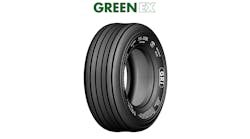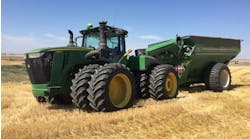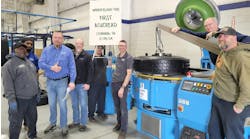Modern Tire Dealer has partnered with AG Tire Talk to provide answers to insightful questions that farm tire dealers have about farm tire technology. This is the next installment in our ongoing series, which is designed to help farm tire dealers better connect with their customers. A trending question, followed by answers, will appear in our Commercial Tire Dealer section every other month. For complete answers, click on www.agtiretalk.com.
QUESTION: What ag tractor segments do you foresee growing with electric power adoption, will any changes be required in current tire lines and what plans, if any, do you have to accommodate higher torque and weight, lower rolling resistance and noise?
ANNIE BOYER, marketing manager, Ascenso Tires North America: We believe that the growth of electric power vehicles in the agricultural tractor segment will come first in the under 40 horsepower (hp) and then move up from there. This smaller segment will be the easiest to transform from a cost-effective point, as well as means of use point, as these tend to be less constant use applications.
We feel that the electric power movement will move directly with the autonomous movement in the future in larger tractors. As autonomy begins to pick up speed, overall tractor sizes will (get) smaller and electric power will be easier to adapt. On-board air will also be standard more and more in the future. Combines and carts will most likely be the last place for EV or autonomous use.
There really won’t be a need for tires to change in a significant way just due to electric operation. Hybrid treads - those that are a mix of R1/R4/R3 - may become more popular just from a noise, roading and a more even compaction area point. The added weight that may come with electric on small tractors will likely require wider and perhaps a little taller tires. There will most likely never be one design that meets all requirements, so there will always be a variety of choices based on specific needs and this fits Ascenso’s plan to build application-specific tires.
Perhaps the greatest need for the future of electrification of vehicles is from the safety aspect of how to safely power and operate these vehicles in harsh environments.
DAVE PAULK, manager, field technical services, BKT USA Inc.: This is a difficult question to answer at this point. With cars, pickups, and trucks coming online, ag tractors will be the next frontier. There are some less than 40 hp electric compact tractors available on the market for light work. Considering all the electric tools now available, from lawn mowers to side by sides, the technology will only get better.
Although larger tractors are likely being tested, it appears the less than 40 to 100 hp market is the first seriously being looked at with utility tractors for full electrification. This market will continue to be developed and grow with new ideas.
How long will it take to make these tractors where they work well and are affordable? A look at history gives some insight into the development of modern tractors and the time it has taken to get us where we are today with gasoline and diesel. When you consider that horses and mules were still being used more than tractors through the 1940s, tractors have made a large jump, brought on by technology and the need to replace labor on farms.
From the 1870s to the 1910s, steam tractors were used in some areas. The first tractor weighed 14,000 pounds and produced 30 hp. They could move under their own power, but because of their mechanical complexity, their size and the constant danger of exploding, they were unusable on most farms. The rate of growth of steam horsepower was far less than the growth in animal horsepower for the time.
The first tractors had the same traits as steam engines, as they were heavy, with steel wheels or tracks, and they were large and expensive. By the mid 1930s, several manufacturers had developed general purpose tractors and replacement of the horse and mule had begun. By 1960, except for in the deep south, the increase in the percentage of farms with tractors had stopped. It took many years to move from horses and mules to tractors.
At some point, as electrification technology gets better and is used on larger-horsepower tractors, tire manufacturers will have to adjust to meet new demands from the equipment. Tire technology now is much better thanks in part to the evolution of mechanical front-wheel drive and four-wheel-drive tractors. The decreasing number of farmers and the distance traveled between farms has forced tire manufacturers to develop tires that ride smoother and will last longer when used on the highway.
Some tractors will now go up to 45 mph. Provisions had to be made and designed to handle those speeds. As electrification advances are made and electric tractors become more commonplace, advances in tire technology will have to keep up with the demands of the equipment.
If you look at large tractors that are currently used, they are heavy and have high horsepower. They produce a large amount of torque. The industry already produces tires that will handle the weight and stress of high torque. At BKT, tires are currently tested for road noise. Since electric tractors produce little engine noise, this may become a higher priority in the future. Rolling resistance is another issue that is currently being tested. Since tractors spend so much more time on the highway, rolling resistance, ride comfort and road noise are issues that are at the top when testing. With electric tractors, rolling resistance dictates how long battery life they will have.
BKT is always looking at market requirements and making changes to accommodate the market and handle the horsepower, torque, and weight of future equipment. As previously stated, BKT already tests for rolling resistance and noise levels. We know this is something being experimented with and are closely monitoring new technology and equipment in the marketplace to supply the best tire possible for these applications.
GREG GILLAND, vice president, global agriculture, Maxam Tire North America Inc.: Sustainability and securing alternative energy sources, including electrification, are driving modern technology developments in compact, less-than-40 hp tractors up to the larger horsepower platforms. As tractors represent well over 70% of the global agricultural machinery, the initial developments are focused on the largest and most relevant part of the market. The challenge for tractor manufacturers in converting to electrification or alternative fuels includes several issues.
Electric vehicles are heavier as the electric motors are located at the wheelbase and eliminate the need for an axle for conventional engine crankshaft and gearing. This poses an increase in tire weight, which contributes to greater potential soil compaction. Currently observed trends on existing electric vehicles in passenger or light truck applications indicate a reduction in tire life of about minus-30%, due to the amount of weight, torque and power that electric engines can deliver.
The need for a longer battery service life is ever-increasing. Electrification energy demands are driving battery life improvements to meet the growing market need. Regardless of the power available, the battery service life will be subject to the amount of torque or consumption applied to work a field. It will be difficult at this stage to either have longer recharging cables or portable replacement batteries available to recharge the heavier 150-plus hp tractor and equivalent machinery that operate in large acreage fields far away from power sources or recharging stations.
In the absence of long-life battery solutions to meet the torque and field demand requirements, I foresee the ag industry moving down the path of alternative fuels in some segments that maintain the same current engine with multi-axle configurations, but with improved environmental or other sustainable capabilities for refueling in the field.
Based on the observed market trends, it seems evident the use of electrification or other sustainable fuels may be evolving to the following platforms. Compact and support tractors below 50 hp represent the greatest immediate opportunity for electric engines and market sustainability solutions. Most of these lower-hp engines are primarily used in smaller farming operations, where compaction due to heavier wheelbase weight is less of an issue due to their role as support machinery with limited weight towing requirements. These types of lighter ag applications are less demanding as higher horsepower tractor platform market demands and therefore represent an easier platform to develop short-range or limited battery life offerings capable of evolving into higher-hp applications.
The 50-plus hp up to 130 hp power range will be the true test of electric developments, as these represent the largest global segment of tractors in the market. Tractors above 50 HP are used as production machinery in smaller farms less than 400 acres, dairy operations or ranching.
The 125-plus hp platforms and up to 600-plus HP 4WD Tractors will be the frontier of alternative fuels or energy, as their mission is centered on heavy-duty farming with large fields of more than 400 acres requiring autonomy, fuel range and power transmission to tow the heaviest pieces of support equipment. The most significant challenge to this equipment is battery life and rechargeability in a remote field application. In the short term, alternative fuels, such as methane, are delivering realistic and sustainable fuel solutions that consume liquid manure as a source of energy. If battery technology improvements can be achieved, then electrification can deliver the power needed for these larger tractors.
The greatest challenge facing tire manufacturers in the quest for electrification or power sustainability solutions will be the tire weight requirements due to heavier loads and the power transmission or torque applied to the tires, resulting in reduced tire life as proven by current electric vehicles.
DAVID GRADEN, operational market manager, agriculture, Michelin North America Inc.: The challenge here is knowing where this technology will go in the near and long-term futures. If I would guess, we will see electric power adaption to less than 40 hp compact and 40 hp to 100 hp utility (tractors) first, then 100-plus hp medium/large ag many years down the road or (the market might) even grow faster in the direction of natural gas and/or hydrogen powered engines. Regardless, the infrastructure for each of these is vastly different from the next, which will ultimately dictate what comes first.
When looking at less than 40 hp compact and 40 to 100 hp utility tractors, the infrastructure is already there, in many cases. These machines are typically used for short periods of time and also tend to operate nearer to utilities. In fact, electrification of these machines may not cost as much as one may think, due to fewer parts needed to make them work. From a tire perspective, however, we can no longer assume that our current rubber compounds and chevron patterns will perform under the torque these electric vehicles can put down.
Whereas diesel/gas-powered engines take time to rev up and put power to the ground, electric engine power is instant. This means, rubber compounds within these tires will need to handle instant torque, as well, without chipping, chunking or tearing apart. Hybrid tread designs will help, but unfortunately, the biggest challenge is creating new rubber compounds that perform under instant torque without giving up something else, like tractive capacity, flotation, carrying capacity, etc. For example, when creating a softer rubber compound to perform in winter, you typically give up longevity/mileage in exchange for high tractive capacity. Simply put, the softer rubber moves and changes shape easily, allowing it to grip the ground better and, thus, better traction. At Michelin, we spend an enormous amount of research and development trying to create tires that perform in all environments. However, there is more work to be done.
We are all witnessing the beginning stages of time where agricultural innovations are just pouring out of the woodwork! As an industry, we are driven by shrinking land and water availability, ever-growing food demand and higher than ever energy consumption.
BLAINE COX, national product manager — agriculture, golf and turf, Yokohama Off-Highway Tires America Inc.: There’s a lot of interest in electric tractors across a wide range of sizes and we, as tire manufacturers, have to keep up. At Yokohama Off-Highway Tires, we’ve already seen electric equipment coming into the mining, construction and industrial segments, so we’re building up our base of experience. What we are learning in those markets shows us how electrification will affect the farm, not only in tractors, but with electric loaders, skid steers and other equipment.
The fundamental challenges to tires are the same across all electric vehicles. The first challenge is that the machines deliver very high torque almost immediately - a truly impressive amount of torque. To handle that force, we need extremely strong beads to minimize slipping, reinforced sidewalls, and extremely strong undertread and tie bar construction to minimize the movement of lugs and tread blocks that can create cracking at the base of the lugs.
Electric vehicles also tend to be heavier than their internal combustion counterparts, so high load index is very important. There again, sidewall strength is critical, along with strong beads and the ability to dissipate heat effectively. Expect to see a lot of all-steel construction and improved compounds.
Rolling resistance will continue to be a major factor in tire design. The less rolling resistance a machine encounters, the longer it can work on a charge. It’s just like fuel efficiency in a diesel tractor. Look for high-efficiency tread designs that minimize rolling resistance, as well as vibration and noise, which can affect operator comfort, machine wea, and the performance of electronic components.
Electric vehicle technology is a very exciting advancement for farmers and can bring farms to new levels of productivity, efficiency and self-sufficiency. As we have with every shift to new technology — from conventional tires to high-flotation, (from) bias to radial (and) to increased flexion/very-high flexion (tires), and new materials — we will help farmers make the most of the opportunity that electric vehicle technology will bring to the market.
CHRIS NEIDERT, ag marketing, training and development manager for Trelleborg and Mitas Tires, Yokohama TWS: I think we can all agree that (electric) battery powered tractors are going to be in some growers’ future. If you read some articles, some will say, ‘In addition to being cleaner and quieter, an electric tractor is much more efficient, since all the energy goes into work, whereas in a diesel tractor, much of it is wasted as heat. In addition, maximum torque is available immediately rather than at rated engine speed. Finally, since the power source has just one moving part, they require very little maintenance. Even the batteries are projected to last 10 years, pending operating cycles and depth of discharge.’
Better for the environment and easier on the farmer, electric tractors bring cost savings, reduced maintenance needs and flexibility to growers. Studies have shown (that) a typical diesel-powered tractor, using the typical life cycle, emits 53 tons of carbon dioxide every year. A single farmer switching to electric would bring those greenhouse gas emissions to zero.
On average, you can expect to pay around $50,000 to $100,000 for an electric tractor, including economical government incentives. You can also expect to save on upkeep, repairs and, of course, the need for fuel. But in every situation, some benefits come together with some drawbacks. Just what’s involved when using an electric tractor versus traditional diesel? If you’re employing an energy-intensive implement or running the tractor for many hours, you may need to fill up on diesel. Most medium to large farmers work long distance areas, making it difficult to recharge the batteries.
Let’s turn our attention to tires on these electric tractors. I need to lay some groundwork. Looking into some of the electric tractors that are now on the market, you will notice the overall tractor size and weight is not very high. The main reason is that battery power is needed to move these tractors. So the heavier the tractor, the bigger the battery required in order to deliver enough working time. With most electric vehicles, the biggest problem is the high weight of current-technology batteries, but tractors need weight for traction, so they would be an ideal electric vehicle. Some estimates have calculated that for battery power to work in the 250 hp tractor range, a 200-kilowatt (kw) strong battery or even more, would be needed. This 200 kw battery pack alone would weigh 3.5 tons.
Looking at the specs of some current electric tractors in the market, overall tractor weights are between 5,720 to 6,700 pounds. With these lower weights and battery capacities, applications are somewhat limited. These kinds of tractors will be used mainly in the yard, feedlots, dairy barns and poultry areas, where distances are short, recharging is available and utility size equipment is required. Vineyard use is another popular application for these tractors. High torque applications will be a challenge due to the potential kw/hp needed as it relates to the battery size. The current power available for electric tractors in the market is between 40 and 75 kw.




